IASbaba's Daily Current Affairs Analysis
Archives
(PRELIMS + MAINS FOCUS)
Climate Change and Forest Fire Link
Part of: GS Prelims and GS-III – Climate change
In news
- Scientists have noted that human-induced climate change promotes the conditions on which wildfires depend.
Important value additions
Wildfire
- It is also called forest, bush or vegetation fire.
- It is any uncontrolled burning of plants in a natural setting such as a forest, grassland which consumes the natural fuels and spreads based on wind, topography.
- These can be incited by human actions, such as land clearing, extreme drought or in rare cases by lightning.
- Three conditions needed for a wildfire: fuel, oxygen, and a heat source.
- Globally, forest fires release billions of tons of Carbon dioxide into the atmosphere.
- Hundreds of thousands of people die due to illnesses caused by exposure to smoke
- Factors: (1) Climate change increases the frequency; (2) Poor land and forest management
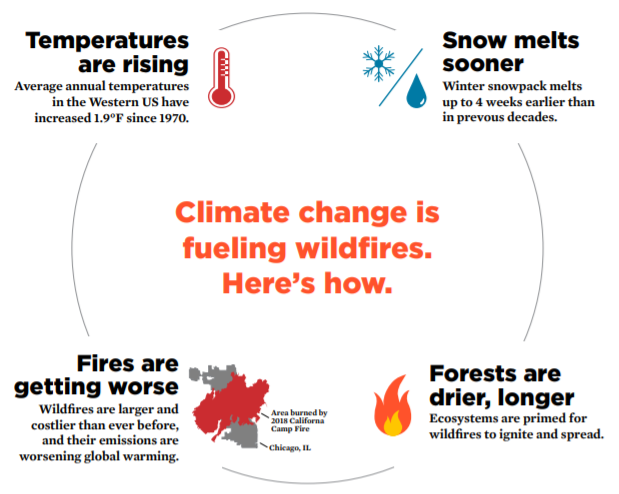
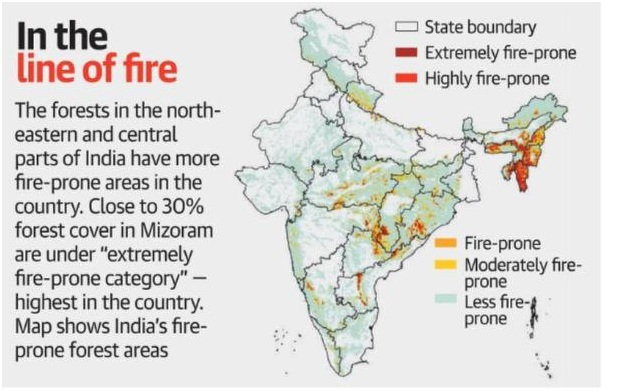
Diffie-Hellman Key Exchange
Part of: GS Prelims and GS-III – Science & Technology
In news
- Recently, television news channels shared leaked WhatsApp chats of film actors in their coverage of an actor’s death.
- It prompted Facebook-owned WhatsApp to come out with a statement on its use of end-to-end encryption to secure user messages.
Key takeaways
- Since 2016, WhatsApp has installed an end-to-end encryption system.
- The encryption ensures that the messages sent on Whatsapp are read and seen by only those people who are communicating.
- The technology that forms the basis for this is called the ‘Diffie-Hellman key exchange’.
- It is a method of securely exchanging cryptographic keys over a public channel.
- It was one of the first public-key protocols as conceived by Ralph Merkle and named after Whitfield Diffie and Martin Hellman.
- The method allows two parties that have no prior knowledge of each other to jointly establish a shared secret key over an insecure channel.
- This key can then be used to encrypt subsequent communications using a symmetric key cipher.
Atal Tunnel inaugurated
Part of: GS Prelims and GS-I – Geography
In news
- Indian Prime Minister recently inaugurated the World’s longest Highway tunnel – Atal Tunnel.
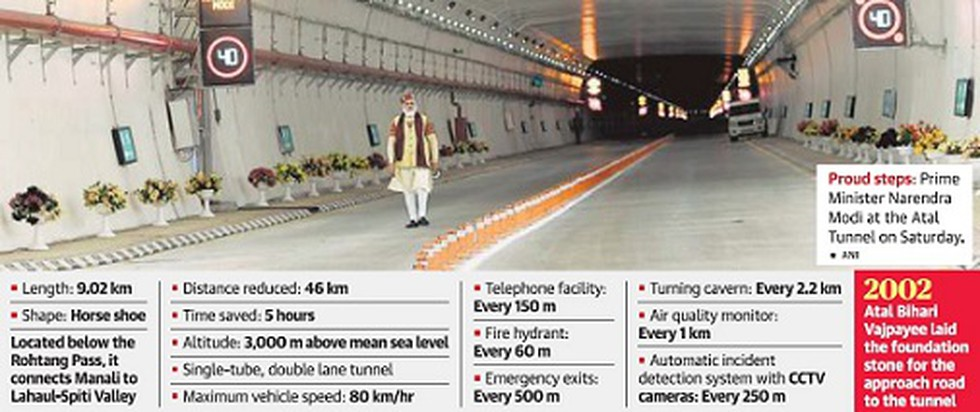
Key takeaways
- Location: Himachal Pradesh and Ladakh
- Constructed by: Border Roads Organisation (BRO)
- The 9.02 Km long tunnel connects Manali to Lahaul-Spiti valley throughout the year.
- Earlier the valley was cut off for about 6 months each year owing to heavy snowfall.
- The tunnel reduces the road distance by 46 Kms between Manali and Leh and the time by about 4 to 5 hours.
- It will provide all weather connectivity to remote border areas of Himachal Pradesh and Ladakh.
- It would also reduce the distance between Manali and Keylong by 3-4 hours.
- Former Prime Minister Atal Bihari Vajpayee laid the foundation of the approach road for this tunnel in 2002.
Successful trial of Shaurya Missile conducted
Part of: GS Prelims and GS-III – Defence; Security
In news
- A successful trial of the nuclear capable Shaurya missile was conducted by India recently.
- Shaurya is a land-based parallel of the submarine launched K-15 missile.
- These ballistic weapons belong to the K missile family — codenamed after late Dr APJ Abdul Kalam — which are launched from the Arihant class of nuclear submarines.
Important value additions
K family of missiles
- The K family of missiles are primarily Submarine Launched Ballistic Missiles (SLBMs).
- These missiles are fired from submarines from India’s Arihant class nuclear powered platforms.
- Indigenously developed by: Defence Research and Development Organisation (DRDO).
- The development of these naval platform launched missiles began in the late 1990s as a step towards completing India’s nuclear triad — the capability of launching nuclear weapons from land, sea and air based assets.
- These missiles are lighter, smaller and stealthier than their land-based counterparts.
- The Agni series of missiles are land-based which are medium and intercontinental range nuclear capable ballistic missiles.
Two new species of pipeworts from the Western Ghats discovered
Part of: GS Prelims and GS-III – Biodiversity
In news
- Scientists from Agharkar Research Institute, Pune have recently discovered two new species of pipeworts from the Western Ghats of Maharashtra & Karnataka.
- Researchers have named the species found in Maharashtra as Eriocaulon parvicephalum for its distinct minute inflorescence size
- Karnataka counterpart has been named Eriocaulon karaavalense indicating the Karaavali coastal region in the state.
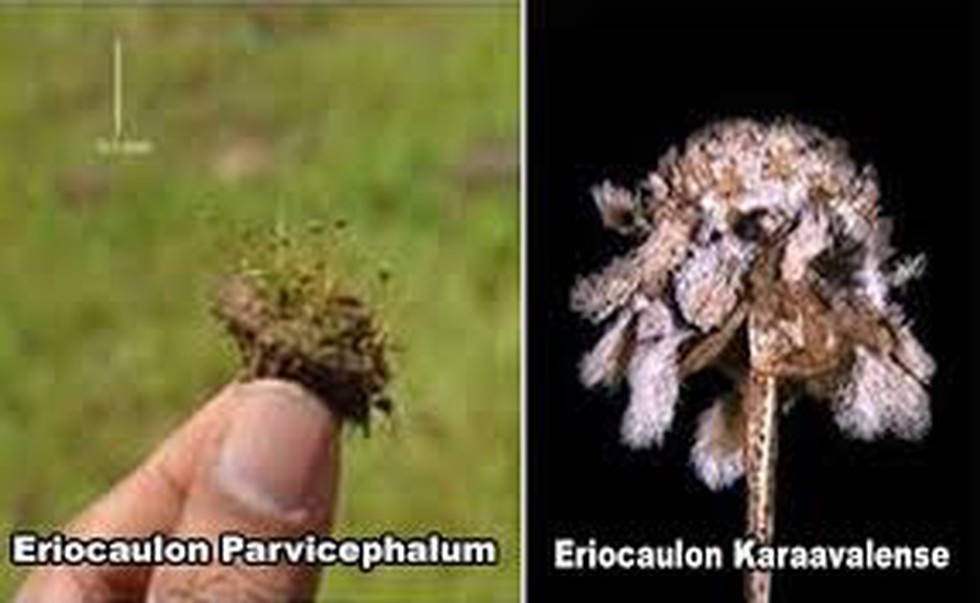
Key takeaways
- Pipeworts is a type of wetland plant.
- It belongs to genus Eriocaulon.
- Some of the previously-discovered plant species have medicinal values
- They also have anti-inflammatory, anti-bacterial and anti-cancerous properties.
- However, the team is yet to trace the hidden medicinal applications of these two species.
- Some 111 species exist in India, most of which are endemic to the Western Ghats and eastern Himalayas.
- The two newly-discovered species display different floral characters than previously known species.
- All species of Eriocaulon appear very similar to one another.
- The team has taken up DNA barcoding works of this species to understand the evolution of this genus in India.
Do you know?
DNA barcoding is a method of species identification using a short section of DNA from a specific gene or genes
High Powered Committee alleges violations in Chardham road project
Part of: GS Prelims and GS-I – Geography
In news
- The chairman of a Supreme Court-appointed expert committee has alleged violations of the court orders in the execution of the Chardham road project.
- It is a 900 km, ₹12,000 crore enterprise to connect pilgrimage spots in Uttarakhand.
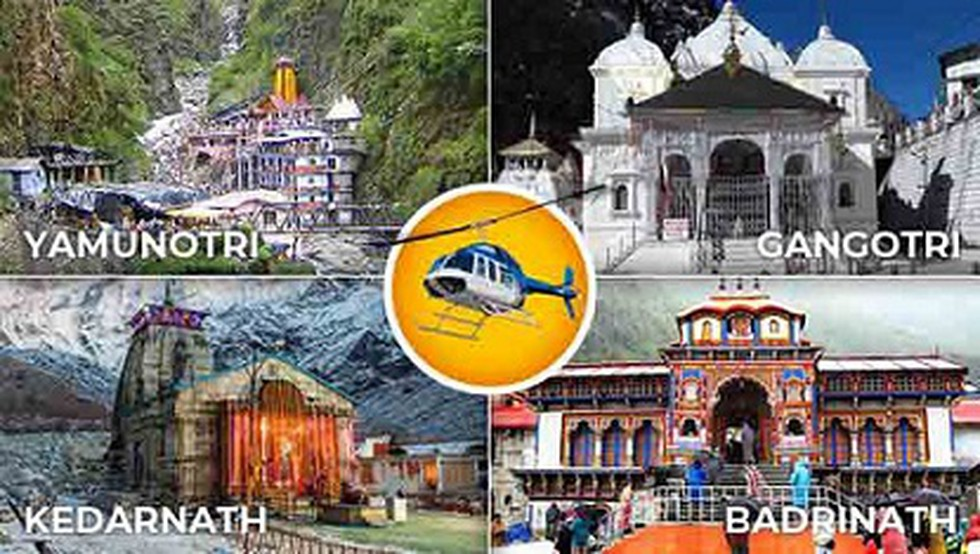
Important value additions
Chardham Yatra of Uttarakhand
- In the great Himalayas in Uttarakhand, the four pilgrim-destinations namely Yamunotri, Gangotri, Kedarnath and Badrinath are collectively known as Chardham.
- Traditionally, this pilgrimage tour should begin from the West and end in the East. Thus, the Char Dham Yatra commences from Yamunotri, then proceeds to Gangotri and finally to Kedarnath and Badrinath.
- The MoRTH is the key coordinator of the Chardham project.
- Ravi Chopra is the chairman of the High Powered Committee (HPC).
Miscellaneous
UAE’s Moon Mission
-
Recently, the United Arab Emirates (UAE) has decided to send an unmanned spacecraft to the moon in 2024.

- The rover would be named Rashid after Sheikh Rashid bin Saeed Al Maktoum, one of the original founding rulers of the UAE.
- Aim: To explore the surface of the moon in areas that have not been explored previously by human missions such as NASA’s Apollo.
The Article 254(2)
- It enables a State government to pass a law, on any subject in the Concurrent List, that may contradict a Central law, provided it gets the President’s assent.
- However, the Parliament is not barred from enacting at any time any law with respect to the same matter including a law adding to, amending, varying or repealing the law so made by the Legislature of the State.
Dhaulasidh Hydro Project
- Indian Prime Minister announced the construction of 66 MW Dhaulasidh Hydro Project at Hamirpur, Himachal Pradesh.
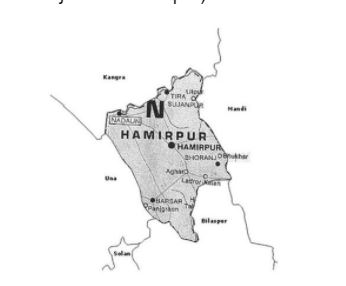
- The project is proposed on the horseshoe curve of the Beas.
- It is planned on the flow of the Beas near the temple at Amli village in Nadaun sub-division of Hamirpur district.
(MAINS FOCUS)
SECURITY/ GOVERNANCE
Topic: General Studies 2,3:
- Effects of liberalization on the economy, changes in industrial policy and their effects on industrial growth
- Government policies and interventions for development in various sectors and issues arising out of their design and implementation.
Offset Clause under Defence Procurement
Context: On 28th September 2020, the new Defence Acquisition Procedure (DAP 2020) was released.
Among other things, the Defence Ministry has removed the offset clause requirement in inter-governmental agreements (IGA) and has introduced a new category for leasing of military equipment.
What is an offset clause in Defence Contract?
- A defence offset policy was promulgated under the Defence Procurement Procedure (DPP-2005) and the first offset contract was signed in 2007
- Definition: Under the offset clause, a foreign company that wins a defence deal is supposed to invest a part of the contract value in the country, thus developing skills and bringing in technology, while also generating employment.
- An offset provision in a contract makes it obligatory on the supplier to either “reverse purchase, execute export orders or invest in local industry or in research and development” in the buyer’s domestic industry
- Valuation for Offset: Under the DPP 2006, the offset value was fixed at 30% of defence deals above ₹300 crore, which was revised to ₹2,000 crore in DPP 2016 for full-import deals.
What are the objectives of Offset clauses?
Comptroller and Auditor General (CAG) Defined offsets as a “mechanism generally established with the triple objectives of:
- (a) partially compensating for a significant outflow of a buyer country’s resources in a large purchase of foreign goods
- (b) facilitating induction of technology and
- (c) adding capacities and capabilities of domestic industry”.
What has been the working of Offset Clause?
- Auditing the offset deals till March 2018, the Comptroller and Auditor General (CAG) said 46 offset contracts were signed for ₹66,427 crores.
- Target: Till December 2018, ₹19,223 crore worth of offsets should have been discharged.
- Actual Implementation: The vendors have claimed discharge of only ₹11,396 crore, 59%, of the offsets. But the Defence Ministry has accepted only ₹5,457 crore of these offset claims, while the rest were pending or rejected due to various deficiencies
- Pending: The remaining offset commitments of about ₹55,000 crore would be due for completion by 2024, but the rate of the offset discharge has been about ₹1,300 crore per year.
- Ineffective: At other times, international vendors reportedly discharged offsets that didn’t necessarily contribute to India’s defence manufacturing prowess, thereby defeating the very purpose of these deals.
Will no defence contracts have offset clauses now?
- Only government-to-government agreements (G2G), ab initio single vendor contracts or inter-governmental agreements (IGA) will not have offset clauses anymore.
- For example, the deal to buy 36 Rafale fighter jets, signed between the Indian and French governments in 2016, was an IGA.
- Ab initio single vendor means that when you start the process you have only one vendor
- According to DAP 2020, all other international deals that are competitive, and have multiple vendors vying for it, will continue to have a 30% offset clause.
Why was the clause removed?
- To reduce procurement cost: Generally, vendors would “load” extra cost in the contract to balance the costs of offsets, and doing away with the offsets can bring down the costs in such contracts.
- To reduce Administrative Costs: There are “administrative costs” involved in discharging offset obligations, which the vendors pay.
- Criticism by CAG about Offsets: CAG audit report “found that the foreign vendors made various offset commitments to qualify for the main supply contract but later, were not earnest about fulfilling these commitments”
- The CAG had also not found “a single case where the foreign vendor had transferred high technology to the Indian industry”.
What are the other changes announced?
- Alternative route: The new rules allow the military to lease equipment from defence companies or foreign governments. This is expected to bring down acquisition time and costs (since leasing is a cheaper alternative to purchasing).
- Enhanced Flexibility: Leasing would also give the Air Force, Army and Navy the flexibility of procuring systems at a time of their choosing.
- Aligned with Atmanirbhar Bharat: The new rules stipulate that under some categories procurement be reserved for “Indian vendors”, which are defined as companies that are owned and controlled by resident Indian citizens with FDI not more than 49%.
- Aligned with Make in India: Along similar lines, the minimum indigenous content (IC) requirement for most projects has also been raised to 50%. If a defence platform is manufactured in India, it must have 60% Indian content
- A new procurement category called “Buy (Global–Manufacture in India)” has been added. Under this category, manufacturers are encouraged to set up facilities in India for assembly, repair and maintenance of equipment.
Conclusion
- Allowing leasing of equipment and liberalising the procurement process seem to be steps in the right direction.
- As for offsets, the evidence suggests that they incurred auxiliary costs whilst not equipping local enterprises with any knowledge or expertise. So, it was probably reasonable to have done away with them.
Connecting the dots:
- Make in India Initiative
- Rafale deal
HEALTH/ GOVERNANCE
Topic: General Studies 2,3:
- Issues relating to development and management of Social Sector/Services relating to Health
Herd immunity for COVID-19
Context: With the COVID-19 cases increasing day by day, the theory of herd immunity has been floating around.
What is Herd Immunity?
- Herd immunity is a form of indirect protection from infectious disease that occurs when a large percentage of a population has become immune to an infection, thereby providing a measure of protection for individuals who are not immune.
- Initially, herd immunity, an important tool in epidemic control, was proposed as a means to overcome the pandemic.
- Only a certain proportion of the population needs to be infected in order to stop large outbreaks, either through naturally-acquired disease, or through vaccination.
- Since a vaccine is not available for COVID-19 yet, some people advocated that the infection be allowed to spread in the community until herd immunity is achieved.
Why is this being stoutly opposed?
- The SARS-CoV-2 virus is easily transmissible and would require around 60-70% of the population to be infected to acquire herd immunity.
- If we allow this to happen naturally, it will take a long time, of course, but more importantly, it is going to do a lot of collateral damage
- So, even if 1 % of people who get infected are ultimately going to die, then this can add up to a huge number of people, if we look at the global population
- Herd immunity is not a strategy or a solution by some but is considered as surrender to a preventable virus
How and when will herd immunity be achieved in this pandemic?
- Herd immunity is achieved when one infected person in a population generates less than one secondary case on an average
- This corresponds to the effective reproduction number R (that is, the average number of persons infected by a case) dropping below 1 in the absence of interventions
- With flu pandemics, herd immunity is usually attained after two to three epidemic waves, each interrupted by the typical seasonality of influenza virus, and more rarely, by interventions
- Currently, there is insufficient confirmed information on re-infection to determine how that will influence the pandemic’s course.
What does the sero-prevalence study in India say?
- A measure of the infection levels in the population is provided through the sero-surveys conducted by the Indian Council of Medical Research (ICMR).
- The second study was done between August 17 and September 22, 2020, and found the prevalence at 15.6% of the population in urban slums and at 8.2% in non-slum areas. The hotspots were not included this time.
- In Delhi, the second round estimated a sero-prevalence of 29.1%. The study revealed that for every reported COVID-19 case, there were 26-32 infections, down from 81-130 infections per reported case in May
Are vaccines the solution?
- Vaccines are particularly suited for creating herd immunity because their allocation can be specifically targeted to highly exposed populations, such as healthcare workers or individuals with frequent contact with customers.
- They may have a significantly greater impact on reducing viral circulation than naturally-acquired immunity, especially if it turns out that naturally-acquired protective immunity requires boosts through re-infections.
- With a vaccine you can achieve immunity and herd immunity safely. Through natural infection also we can achieve it at some point, but it would be at great human cost.
Conclusion
Until a vaccine is readied, it would be best to take actions that would slow down the progress of the virus —wearing a mask, physical distancing and following hand hygiene
Connecting the dots:
(TEST YOUR KNOWLEDGE)
Model questions: (You can now post your answers in comment section)
Note:
- Correct answers of today’s questions will be provided in next day’s DNA section. Kindly refer to it and update your answers.
- Comments Up-voted by IASbaba are also the “correct answers”.
Q.1 Recently, World’s longest Highway tunnel – Atal Tunnel was inaugurated. Consider the following statements:
- It is constructed by Ministry of Road Transport and Highways.
- It connects Manali to Mussoorie throughout the year.
Which of the above is/are correct?
- 1 only
- 2 only
- Both 1 and 2
- Neither 1 nor 2
Q.2 Consider the following statements regarding K family of missiles:
- These are primarily Land based Ballistic Missiles.
- These are indigenously developed by Department of Science and Technology.
Which of the above is/are correct?
- 1 only
- 2 only
- Both 1 and 2
- Neither 1 nor 2
Q.3 Some 111 species exist in India of Eriocaulon. These species are endemic to which of the following part of India?
- Western Ghats
- Eastern Himalayas
- Eastern Ghats
- Both (a) and (b)
ANSWERS FOR 3rd October 2020 TEST YOUR KNOWLEDGE (TYK)
| 1 | B |
| 2 | B |
| 3 | D |
| 4 | A |
Must Read
About Sep GST data:
About NEP and English Language:
About QUAD:













